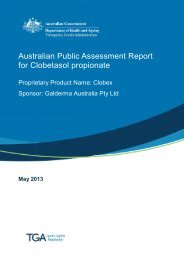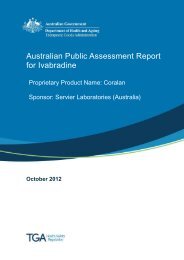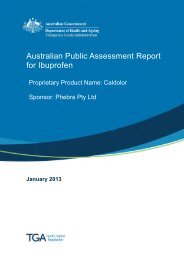CHMP position statement on Creutzfeldt-Jakob disease and plasma ...
CHMP position statement on Creutzfeldt-Jakob disease and plasma ...
CHMP position statement on Creutzfeldt-Jakob disease and plasma ...
Create successful ePaper yourself
Turn your PDF publications into a flip-book with our unique Google optimized e-Paper software.
sourced from urine collected in the UK. Based <strong>on</strong> the limited data <strong>on</strong> human exposure to BSE-risk<br />
materials in other countries, it is still difficult to estimate the epidemiological risk in those countries<br />
which have a small number of vCJD cases or may have a TSE exposure risk.<br />
For particular products, such as horm<strong>on</strong>es from a relatively small well-defined d<strong>on</strong>or populati<strong>on</strong>, some<br />
manufacturers have put in place limited exclusi<strong>on</strong> criteria for the selecti<strong>on</strong> of a d<strong>on</strong>or for inclusi<strong>on</strong> in a<br />
d<strong>on</strong>or panel. For other products manufactured from very large d<strong>on</strong>or pools (e.g. urokinase), such<br />
measures are more difficult to apply. The use of exclusi<strong>on</strong> criteria for selecti<strong>on</strong> for a d<strong>on</strong>or panel is<br />
encouraged. The same exclusi<strong>on</strong> criteria should be applied with respect to CJD <strong>and</strong> vCJD as used for<br />
blood/<strong>plasma</strong> d<strong>on</strong>ors providing starting material for the manufacture of <strong>plasma</strong>-derived medicinal<br />
products. Manufacturers should follow up the d<strong>on</strong>or criteria at defined intervals. The exclusi<strong>on</strong> of<br />
d<strong>on</strong>ors with known inflammati<strong>on</strong> of kidney <strong>and</strong>/or chr<strong>on</strong>ic renal inflammatory <strong>disease</strong>s is encouraged.<br />
Manufacturers are required to estimate the potential of their specific manufacturing processes to<br />
reduce infectivity following the same general, stepwise approach as recommended for <strong>plasma</strong> derived<br />
medicinal products (see Secti<strong>on</strong> 9.2.3). Extrapolati<strong>on</strong> of results for <strong>plasma</strong>-derived medicinal products<br />
is not justified particularly for chromatographic steps at the beginning of the manufacturing process<br />
because of the high protein c<strong>on</strong>tent in <strong>plasma</strong>. Investigati<strong>on</strong>al studies of infectivity reducti<strong>on</strong> by the<br />
manufacturing processes should address potential accumulati<strong>on</strong> of infectivity/PrP TSE <strong>on</strong><br />
chromatographic columns or a potential batch to batch c<strong>on</strong>taminati<strong>on</strong> due to carry-over of<br />
infectivity/PrP TSE . For inactivati<strong>on</strong> studies, investigati<strong>on</strong> of different TSE strains should be c<strong>on</strong>sidered as<br />
they may vary in resistance.<br />
General review of the manufacturing processes indicates that, in each manufacturing process, there is<br />
at least <strong>on</strong>e step that might be theoretically capable of reducing infectivity if it were present in the<br />
starting material. In cases where the reducti<strong>on</strong> capacity is limited, manufacturers should c<strong>on</strong>sider the<br />
additi<strong>on</strong> of steps that may increase the overall removal capacity.<br />
Record keeping for traceability is recommended for products where it is possible to trace back to d<strong>on</strong>or<br />
level.<br />
19/26
















